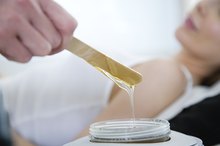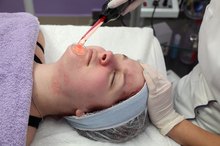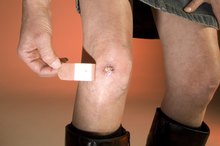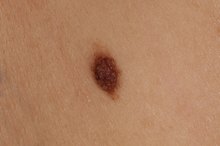How to Get Rid of Scratch Scars
Anything from a deep gouge to a light, seemingly harmless scratch can create a scar, which occurs when tissue forms over a wound that is healing. Most scars appear lighter in color than the unaffected skin around them. Depending on their size and location, scars can be disfiguring or distracting, but there are ways to lessen their appearance. A scar from a scratch is easier to eliminate than one from a deep wound.
Visit a dermatologist for dermabrasion treatment, which can be very effective on light scarring. Dermabrasion works by wearing away at the top layer of skin with a fast-moving wire, brush, diamond or other stone. The hard object skims the skin and scar tissue. The heat created by a dermabrasion treatment stimulates new cell growth, which should result in lightening -- and in many cases near removal -- of a scar from a scratch. Most dermatologists recommend two to four dermabrasion treatments. Side effects can include red and sensitive skin at the location of treatment.
How to Fade Scars From Chemical Burns
Learn More
Undergo a chemical peel treatment by a dermatologist or certified specialist. Chemical peels are similar to dermabrasion, but there is a greater risk of scarring if a chemical is misapplied, according to the American Academy of Dermatology 1. These peels use an acid, often glycolic acid, to burn off the top layers of your skin and stimulate new skin growth. Depending on the visibility of your scar, you may need anywhere from one to eight treatments to eliminate the scar tissue. Another option is to purchase a chemical peel kit and apply it yourself at home, but follow directions carefully to prevent further skin damage.
Receive a pulsed dye laser treatment, which uses concentrated yellow light to eliminate redness and flatten scars. This treatment by a dermatologist can help resurface your skin, returning it to its original condition. Other laser treatments can be successful in killing off scar tissue, particularly the kind that resides beneath the surface of the skin and can't be easily treated with topical methods. As with chemical peels, the number of treatments depends on the amount of scar tissue. Most scars require multiple treatments, but for scratch scars, four treatments should be sufficient.
Tips
For deep scars or those on the face, you can schedule surgery to remove scar tissue. This is the most invasive scar treatment option and requires more healing time. It can also be the most expensive option and poses the highest risk of residual scarring. Surgery is often viewed as a last resort and is rarely needed for light scars, such as those resulting from a scratch.
Related Articles
References
- American Academy of Dermatology: Acne Scars
- Saint-jean M, Khammari A, Jasson F, Nguyen JM, Dréno B. Different cutaneous innate immunity profiles in acne patients with and without atrophic scars. Eur J Dermatol. 2016;26(1):68-74. doi:10.1684/ejd.2015.2713
- Archer CB, Cohen SN, Baron SE. Guidance on the diagnosis and clinical management of acne. Clin Exp Dermatol. 2012;37 Suppl 1:1-6. doi:10.1111/j.1365-2230.2012.04335.x
- Woolery-lloyd H, Kammer JN. Treatment of hyperpigmentation. Semin Cutan Med Surg. 2011;30(3):171-5. doi:10.1016/j.sder.2011.06.004
- Hedelund L, Haak CS, Togsverd-bo K, Bogh MK, Bjerring P, Haedersdal M. Fractional CO2 laser resurfacing for atrophic acne scars: a randomized controlled trial with blinded response evaluation. Lasers Surg Med. 2012;44(6):447-52. doi:10.1002/lsm.22048
- Hedelund L, Moreau KE, Beyer DM, Nymann P, Haedersdal M. Fractional nonablative 1,540-nm laser resurfacing of atrophic acne scars. A randomized controlled trial with blinded response evaluation. Lasers Med Sci. 2010;25(5):749-54. doi:10.1007/s10103-010-0801-1
- Kim EK, Hovsepian RV, Mathew P, Paul MD. Dermabrasion. Clin Plast Surg. 2011;38(3):391-5, v-vi. doi:10.1016/j.cps.2011.05.001
- Wollina U, Goldman A. Fillers for the improvement in acne scars. Clin Cosmet Investig Dermatol. 2015;8:493-9. doi:10.2147/CCID.S86478
- Fabbrocini G, Annunziata MC, D'arco V, et al. Acne scars: pathogenesis, classification and treatment. Dermatol Res Pract. 2010;2010:893080. doi:10.1155/2010/893080
- Alexiades M. "Laser and Light-Based Treatments of Acne and Acne Scarring." Clinics in Dermatology. 2017 Mar - Apr;35(2):183-189.
- Fife D. "Evaluation of Acne Scars: How to Assess Them and What to Tell the Patient." Dermatologic Clinics. 2016 Apr;34(2):207-13.
- Werschler WP, Few JW, Jacob CI, Joseph JH, Spencer JM, Taub AF. "Advancing the Care of Post-Acne Scarring: Expert Insights Into New Treatment Options." Journal of Drugs in Dermatology. 2016 May 1;15(5):518-25.
- Zaleski-Larsen LA, Fabi SG, McGraw T, Taylor M. "Acne Scar Treatment: A Multimodality Approach Tailored to Scar Type." Dermatologic Surgery. 2016 May;42 Suppl 2:S139-49.
- Zouboulis CC, Bettoli V. "Management of Severe Acne." British Journal of Dermatology. 2015 Jul;172 Suppl 1:27-36.
Writer Bio
Jonathan Croswell has spent more than five years writing and editing for a number of newspapers and online publications, including the "Omaha World-Herald" and "New York Newsday." Croswell received a Bachelor of Arts degree in English from the University of Nebraska and is currently pursuing a Master's of Health and Exercise Science at Portland State University.









